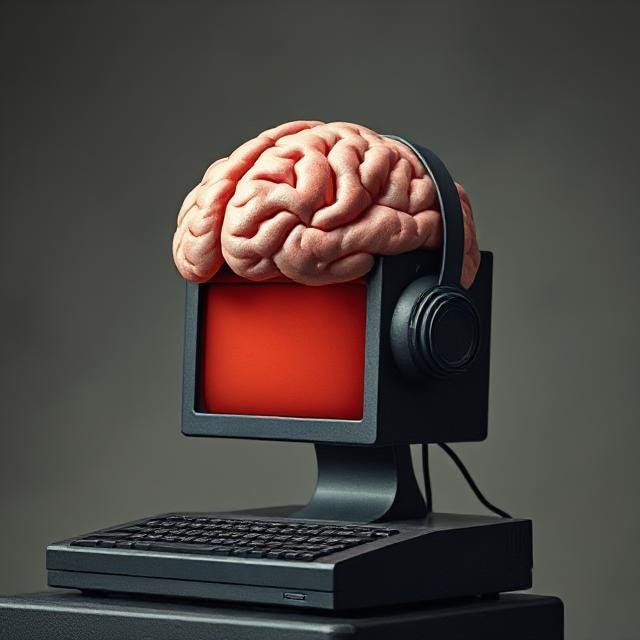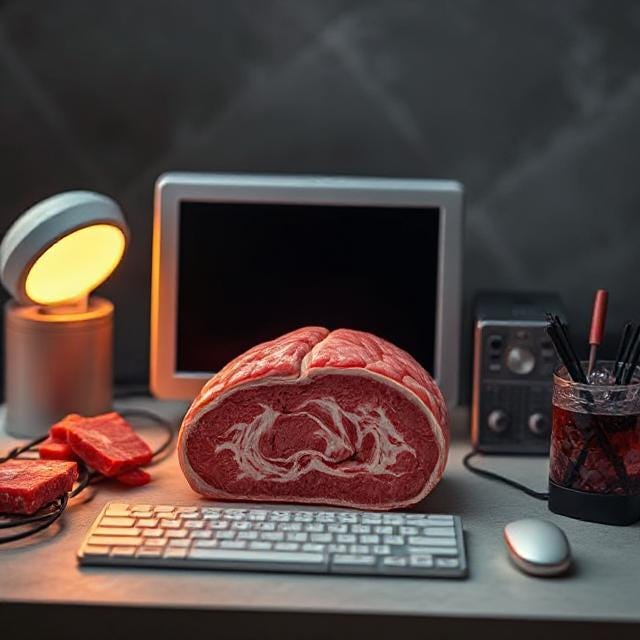Artificial Intelligence is Computerized Brainmeat
Part One of Dr. Mqx's Deep Dissection Series on AI in medicine.

The AI Is Right Behind Me, Isn’t It?
Right now, AI is everything. It’s everywhere. It’s all at once an inescapable eventuality. I feel like half the news stories I read deal with AI or something related to it. Back when I was on Facebook, every handful of doom-scrolled pictures was a hacky AI generated image of the most banal subjects. A bland and obviously fake image of “the perfect woodshop”, for instance, had hundreds of comments in awe of its meticulous organization. All that despite the fact that the tool on the workbench didn’t exist in reality and the table it was sitting on had 7 legs for some reason.
AI Contains Multitudes
I want to know what AI is, so I sought a source. Pushing past Google’s recommendation for its own explanation, I found NASA had a handy guide for me, albeit one that suggested no succinct definition exists. Fair enough. If I had to try and approximate the take home message, it would say something to the effect that AI seems to be a computer-based system that is able to solve complex tasks or create things much in the same way a human brain might. This involves computers understanding how our human language and communications systems work, which, in turn, seems to be important to allow the AI to learn from and interact with us. NASA also used the term “neural networks” to describe how the computer systems try to do the above tasks. As a physician, I wanted to know more about that because my mind’s eye was picturing a gooey bit of brainmeat slapped onto a motherboard. That’s probably not how this works.
According to an MIT News article I found, computer scientists have been interested in brainmeat architecture and computing for a while–since the 1940’s even. Sci-fi movies and literature of years past had recurring fascinations with brains as computers so I suppose that makes sense. That fascination continued well into modern times. If I don’t get too sidetracked into thinking about the Robocop movie series as a metaphoric reckoning between the human-machine dichotomy, I can remember the scene from Robocop II where the villain Cain was killed so his brain could float in a container with wires so the bad guys could harness its evil computing power to make a robot that had substance use disorder. It’s a weird choice. I’d want my murder-bot to be focused and clear-headed.

Learning Deep and Stuff
After reading a single article on the matter, I’m confident that I understand computing systems behind IT are complicated. From what I did comprehend, much of the AI computing architecture seems to rely on something called “deep learning.” Sadly, this doesn’t mean one’s computer is entering into a profound state of focused intellectual betterment, though I’d like to imagine my CPU pining for a more meaningful existence while I’m using it to watch reruns on YouTube of the worst wrestling pay-per-views WCW had to offer.
What follows is everything I gleaned from that MIT article. Don’t cite the next paragraph in your computer science dissertation. You’ve been warned.
As far as I understand it, deep learning has to do with the actual depth–in terms of the third dimension–of the layers of the processing chip that is put to task to do the work of helping computers learn things without a human telling them what things are. Layers of information processing nodes are stacked on top of each other, pushing forward information to the next node and next layer above them. Information moves forwards in this architecture from input to output, except where it doesn’t and can go backwards from output to input. More layers of nodes mean more avenues for processing of things like language or images.
I hope you’re as confused as I am.
I’m well aware I don’t fully understand this concept. I found this guy at IBM who does, in case you’re interested. He seems reasonably charming and has a whole series of videos on the matter. He also talks about pizza.
The gist seems to be that using this type of system, the computers with the deep learning capabilities can distinguish between objects like basketballs, baseballs, and hockey pucks if you want them to. They can do this from raw, unlabeled chunks of data–think, piles of images online.
Earlier forms of computer learning, prior to the deep learning stuff, needed humans to tell the computer systems what a basketball, baseball, or hockey puck was once the computer had distinguished there was a difference between images of the three objects. Human brains were needed to classify the data into useful bits until deep learning came along. Deep learning models avoid the need for human brains to interpret what data is useful, and, if you look at human behavior en masse, maybe it’s safer for computers not to rely on our prioritizing of important things.
While the computer learning parts were a first step, further research had to be done in the ivory towers of computer science to figure out how to make computers know why distinguishing between objects (or words) was important. This seems to be where the cutting edge of AI technology is these days. AI is the result of taking the deep learning models and fitting them into an interface where the computer systems can make sense of what we’re asking, understand our language, compute super hard to recognize patterns and analyze what’s important, and harness this amazing technology to write a college paper in milliseconds so as to free up one’s afternoon to play Call of Duty instead.
Certified Organic Brainmeat is Complex AF
The neat thing to me as a physician is the relationship between the neural networks to our functioning brainmeat networks. Neural aka brain-related, tissues are made up of an average of 86 billion brain cells, give or take 8 billion or so from brain to brain. Brain cells are also called neurons. Each neuron is connected to other neurons and pass information by releasing chemicals at the microscopic connections between them. In fact, a single neuron might be connected with 1,000 other neurons. With an estimated 100 trillion (with a “truh”) connections between our neurons, the human brain can deep learn like a mofo, scientifically speaking.

Further, while computers can use simple boring electrons to pass information between their little nodes, our neurons use a variety of chemicals called neurotransmitters to pass information in those neuron-to-neuron connections. Fun substances like serotonin, norepinephrine, and acetylcholine all get released between different kinds of neurons so that they can carry signals forward into and out of the brain in an effort to interact with the world around us and, in some cases, to make our lives complicated. I don’t know why my billions of neurons choose to sprinkle neurotransmitters all over each other at 3:00 AM remembering something dumb I did in middle school instead of sleeping, but we’re wired that way.
Synthesizing the Sauce
My take home message from all of my shallow learning is that neural networks are the term for the hardware used to do deep learning and their structure is based on that of our own microscopic brain anatomy. Deep learning is a foundational method that allows computing systems to teach themselves things. AI computer systems can use neural network based deep learning to learn and recognize patterns as a way to make sense of raw undifferentiated data. The more recent work of artificial intelligence computing has seemed to allow computers to analyze all that data they’re collecting and turn it into a useful product–much in the way a human brain recognizes patterns and makes sense of the universe.
So when I ask ChatGPT to brainstorm titles for this series on unpacking and learning about this very topic at hand, it can analyze the words I’ve typed in, associate that data with its enormous deeply learned training, figure out the context of what I’m asking, and burn through enough electrons to warm a small cottage to spit out things like, “Oops, I Researched It Again,” “Lost in the Research Sauce,” and “Boldly Going Where I Have No Idea.”
I don’t hate the last one, to be fair, and I’ll bet “research sauce” has an umami flavor.
My neural networks are spent wrapping my mind around this. I think I have enough to proceed to the next way-point in exploring what AI in medicine might look like. How will the deep learning of these machines help me and my patients lead more enjoyable and fulfilling lives?
Hell if I know, but I’m eager to find out.




My brain meat thought up this comment.